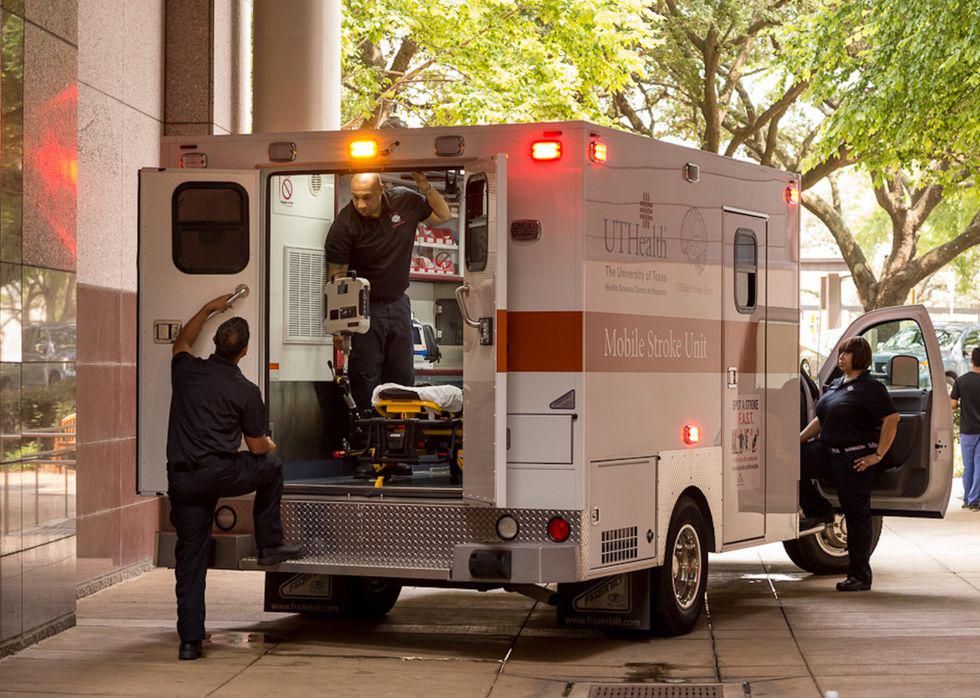THURSDAY, Sept. 9, 2021 (HealthDay News) — Every second counts after having a stroke, and rapid-response mobile stroke units can start clot-busting drugs quickly, potentially staving off lasting damage, new research finds.
Mobile stroke units are special ambulances equipped with imaging equipment and staffed by experts who can diagnose and treat strokes in the moments before arriving at the hospital. Typically, people who may have had a stroke must wait until they get to an emergency room for evaluation and treatment, which can cost valuable time.
In this study, people who were treated on a mobile stroke unit had lower levels of disability three months after their stroke, compared with folks who received treatment when they got to the ER.
“Bringing stroke treatment to the patient using a mobile stroke unit … results in more patients getting treated, faster treatment, and most importantly better outcomes, such as less paralysis, loss of speech or intellect, which results in less disability from the stroke compared to standard management where treatment is not started until after emergency department arrival,” said study author Dr. James Grotta.
Grotta is director of stroke research at the Clinical Institute for Research and Innovation at Memorial Hermann-Texas Medical Center in Houston and founder and director of the Houston Mobile Stroke Unit Consortium.
The study showed that for every 100 people who have a stroke and get treated in a mobile unit, 27 will have less disability and 11 more will completely recover, Grotta said.
More than a half-hour saved
The study also found a 36-minute shorter median time from stroke onset to start of treatment (72 minutes versus 108 minutes). And after three months, 55% of the mobile unit patients had returned to normal activities versus 44% of standard emergency-care patients.
Ischemic strokes are the most common type of stroke. They occur when a blood clot cuts off blood supply to the brain. A clot-busting drug, tissue plasminogen activator (tPA), is extremely effective at preventing lasting disability such as paralysis or speech issues following a stroke, but only if it is given within 4.5 hours of stroke onset, and the sooner, the better.
The study began in 2014 with the launch of the UTHealth Mobile Stroke Unit in Houston and ran through 2020. It included more than 1,500 patients and was expanded to six cities. Overall, 1,047 people were deemed eligible to receive tPA. Of these, 617 received care on the mobile unit.
People treated on the mobile unit were more likely to receive this drug in the critical first hour after a stroke. Up to 70% of people who are treated with tPA in the first hour will recover without any lasting damage, Grotta said.
Time is brain, he added.
“Brain cells die within minutes when deprived of blood and the oxygen that blood carries,” Grotta said. “Getting the artery open as fast as possible is the key to successful treatment.”
The cost of running one of these units is a consideration. A mobile stroke unit costs about $1 million to buy and about $500,000 a year to operate, Grotta said. “It’s expensive, but it saves lives and money to the health care system by reducing the need for long-term disability care,” he said.
For this to be widely implemented throughout the country, appropriate reimbursement from insurers will be necessary. “This is something we are working on,” Grotta said.
The study appears in the Sept. 9 issue of the New England Journal of Medicine.
The new findings dovetail with a recent study that showed staff on mobile stroke units can perform an emergency procedure on stroke patients that significantly improves their chances of survival and a good recovery. The procedure, endovascular thrombectomy, can remove large blood clots blocking blood flow to the brain.
Like a house on fire
Implementing mobile stroke units will be a game-changer for stroke care, said Dr. Kennedy Lees, a professor of cerebrovascular medicine at the University of Glasgow in Scotland. He wrote an editorial accompanying the study.
Lees likens stroke treatment to dealing with a house on fire: “Get the fire service there immediately, and the flames may be put out with only minimal loss of your property, and repairs may be near invisible,” he explained. “Wait 90 minutes, and damage may be irreparable.”
These are “terrific results,” agreed Dr. Deepak Bhatt, executive director of interventional cardiovascular programs at Brigham and Women’s Hospital Heart and Vascular Center in Boston.
“Mobile stroke units bring the therapy to the patient who is potentially having a stroke,” said Bhatt, who had no ties to the new study. “They may make the diagnosis much quicker than if the patient was taken to their local emergency room, and they are able to deliver potent clot-busting drug therapy immediately, thereby saving brain cells that might otherwise die while a patient is being transported to the hospital and the initial assessment begins there.”
Knowing the warning signs of a stroke and acting quickly is essential, Bhatt said. Think F.A.S.T. — the acronym to remember the signs of stroke: Face drooping, Arm weakness or Speech difficulty mean it’s Time to call 911, he said.
More information
Learn more about the signs of stroke at the American Heart Association.
SOURCES: James Grotta, MD, director, stroke research, Clinical Institute for Research and Innovation, Memorial Hermann-Texas Medical Center, Houston, and founder and director, Houston Mobile Stroke Unit Consortium; Kennedy Lees, MD, professor, cerebrovascular medicine, University of Glasgow, Glasgow, UK; Deepak Bhatt, MD, executive director, interventional cardiovascular program, Brigham and Women’s Hospital Heart and Vascular Center, Boston; New England Journal of Medicine, Sept. 9, 2021
Copyright © 2025 HealthDay. All rights reserved.

